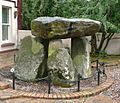List of megalithic monuments in Ireland facts for kids
This is a list of incredible megalithic monuments found all over Ireland. These are huge stone structures built by people long, long ago, often for burials or special ceremonies. Imagine ancient builders moving massive stones without modern machines! These amazing sites include burial places like passage tombs, portal tombs, and wedge tombs (also called dolmens). They also include ceremonial spots like stone circles and stone rows.
Contents
What Are Megalithic Monuments?
Megalithic means "made of big stones." These monuments are prehistoric structures, meaning they were built before written history. They tell us a lot about the people who lived in Ireland thousands of years ago. These ancient builders used their knowledge of engineering and astronomy to create these lasting landmarks.
Why Were They Built?
Most megalithic monuments were built for two main reasons:
- Burial Sites: Many were tombs where ancient people buried their dead. These tombs could be simple or very complex, sometimes holding many burials.
- Ceremonial Sites: Others were used for special gatherings, rituals, or to mark important events. Some might have been connected to the sun, moon, or stars.
How Old Are They?
These monuments are incredibly old! Many were built during the Neolithic (New Stone Age) and Bronze Age, which means they are between 4,000 and 6,000 years old. Think about that – they were built long before the pyramids of Egypt!
Types of Amazing Stone Monuments
Ireland is famous for its many different kinds of megalithic sites. Each type has its own unique design and purpose.
Passage Tombs: Ancient Burial Mounds
Passage tombs are large burial mounds with a long stone passage leading to a central burial chamber. The whole structure is usually covered by a mound of earth or stones called a cairn. Some of the most famous ones are aligned with the sun during important times of the year, like the winter solstice.
- Annadorn Dolmen in Down
- Carrowkeel Tombs in Sligo (5,100–5,400 years old)
- Dowth in Meath (part of Brú na Bóinne)
- Giant's Ring in Down
- Knockmany Passage Tomb in Tyrone
- Knockroe Passage Tomb in Kilkenny
- Knowth in Meath (part of Brú na Bóinne)
- Newgrange or Sí an Bhrú in Meath (part of Brú na Bóinne, 5,000 years old)
- Tibradden in Dublin
- Townleyhall in Louth (part of Brú na Bóinne)
Portal Tombs: Giant Stone Gateways
Portal tombs are often called "dolmens." They look like giant stone tables or gateways. They usually have two tall upright stones (the "portal" stones) with a huge capstone resting on top. These were also used as burial places.
- Ballykeel Dolmen in Armagh
- Ballylumford Dolmen in Antrim (4,000 years old)
- Brownshill Dolmen in Carlow (5,000–6,000 years old)
- Goward Dolmen in Down
- Kilclooney More in Donegal (has two portal tombs)
- Kilmogue in Kilkenny
- Legananny Dolmen in Down
- Meehambee Dolmen in Roscommon (5,500 years old)
- Poulnabrone dolmen in Clare
- Slidderyford Dolmen in Down
Wedge Tombs: Stone Age Burial Chambers
Wedge tombs are shaped like a wedge, getting narrower and lower from the front to the back. They are usually found in the west and southwest of Ireland. They were built later than passage or portal tombs, during the Bronze Age.
- Ballyedmonduff Wedge Tomb in Dublin
- Coom Wedge Tomb in Kerry
- Kilmashogue in Dublin (also has portal tombs and standing stones)
- Labbacallee in Cork
- Lisnadarragh Wedge Tomb in Monaghan
Court Tombs: Open-Air Burial Places
Court tombs have an open, U-shaped or oval courtyard area at the front, leading into a burial chamber. It's thought that ceremonies or gatherings took place in these courtyards.
- Aghanaglack in Fermanagh (a double court tomb)
- Audleystown Court Tomb in Down
- Ballyalton Court Tomb in Down
- Ballymacaldrack Court Tomb in Antrim
- Cloghanmore in Donegal
- Cohaw in Cavan
- Gartnanoul in Cavan
- Kilclooney More in Donegal (also has two portal tombs)
Stone Circles and Rows: Mysterious Alignments
Stone circles are rings of standing stones, while stone rows are lines of stones. These were likely used for ceremonies, marking important dates, or observing the sky.
- Ardgroom in Cork (stone circle)
- Aughlish in Londonderry (stone circles)
- Ballynoe stone circle in Down
- Beaghmore in Tyrone (stone circles and cairns)
- Beltany stone circle in Donegal
- Bocan Stone Circle in Donegal
- Bohonagh in Cork (stone circle)
- Carrigagulla in Cork (stone circles and rows)
- Castlenalacht Stone Row in Cork
- Corick in Londonderry (stone circles)
- Drombeg stone circle in Cork (a recumbent stone circle)
- Drumskinny in Fermanagh (stone circle and cairn)
- Eightercua in Kerry (stone row, 3,700 years old)
- Grange stone circle in Limerick
- Kealkill stone circle in Cork
- Knocknakilla in Cork (stone circle and standing stone)
- Templebryan Stone Circle in Cork
- Uragh Stone Circle in Kerry
Standing Stones and Cairns: Other Ancient Markers
Standing stones are single upright stones, often marking a special place or boundary. Cairns are mounds of stones, sometimes covering a tomb.
- Carnfree in Roscommon (cairns, standing stones)
- Castlestrange stone in Roscommon (a decorated standing stone)
- Lia Fáil in Meath (a famous standing stone)
- Loughcrew Cairns in Meath (5,300–5,500 years old)
- Moylehid in Fermanagh (passage tomb, cairn)
- Tallowroe in Galway (standing stone)
- Turoe stone in Galway (a decorated standing stone)
Other Important Sites
Some sites are very large and contain many different types of monuments.
- Carrowmore in Sligo (has various types of monuments)
- Faulagh in Mayo (various types)
- Glantane East in Cork (various types)
- Knockmaree Dolmen in Dublin (a cist, which is a small stone-lined burial box)
- Knocknarea in Sligo (various types)
- Listoghil in Sligo (part of Carrowmore, 5,380–5,640 years old)
- Magh Slécht in Cavan (various types)
Images for kids
See also
























































